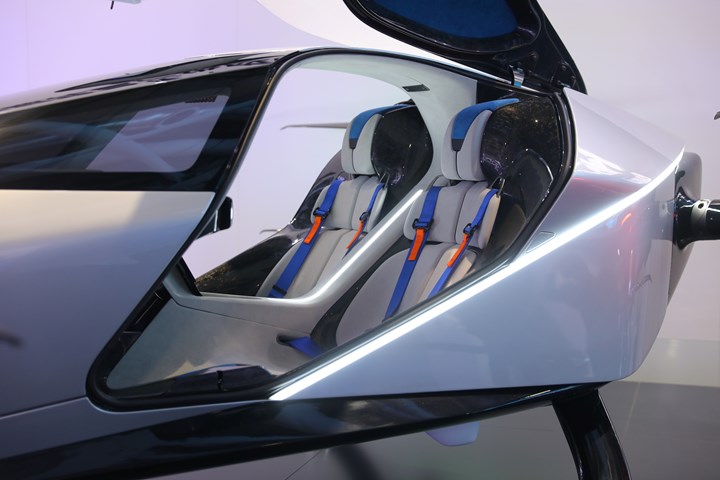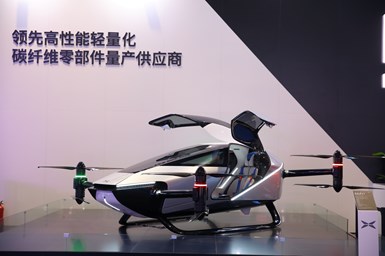HRC manufactures CFRP parts for XPeng HT Aero’s X2 eVTOL aircraft
HRC has successfully developed, delivered and assembled more than 100 types of carbon fiber parts for this futuristic eVTOL.
Share
Read Next

X2 on display at the China International Import Expo. Photo Credit: HRC Group
Corresponding with the X2 electric vertical takeout and landing (eVTOL) aircraft displayed at its booth at the China International Import Expo (CIIE) in Nov. 2021, composites solutions provider HRC Group (Shanghai, China) has officially announced its close cooperation with eVTOL manufacturer XPeng HT Aero (Guangzhou, China). Attractive features included its use of carbon fiber for lightweighting.
The exclusive carbon fiber parts manufacturer of X2, HRC reports that it has successfully developed and delivered more than 100 types of carbon fiber parts for its futuristic “flying car,” including positioning, installation and assembly. Material design was initially defined by HRC’s technical team — including specific types of carbon fiber sheet molding compound (SMC) for the seat frame and control panel — and the engineering team solved the challenges of lamination prior to autoclave cure. In addition, the parts were gloss painted to achieve a classy final finish.
In all, the X2’s carbon fiber components comprise the cockpit, seats, mechanical arm and other structural, interior and exterior parts, together with more than 200 metal and plastic parts, and more than 1,000 standard parts. This is not to mention a 3.8-meter, large-size floor covering. Overall, HRC Group says its aircraft demonstrates complete composite know-how mastery, from sheet to final product.

To meet specific technical targets, structural parts engineering was crucial and technology-intensive. HRC conducted batch production with optimized tooling of complex structural parts like the AB pillar. The large, A-shaped part of the complete AB pillar is made as a hollow structure while the two ends are solid structures. The process is a combination of compression molding and autoclave cure. Consistent wall thickness and precise molding of the part passed aviation-grade ultrasonic non-destructive testing (NDT), says HRC. Moreover, for the supporting arm, HRC engineers designed a special positioning mechanism which could meet the high-precision positioning requirements of metal pre-embedded parts. The X2 weighs only 560 kilograms (~1,235 pounds) with batteries and can carry two passengers with a maximum load of 200 kilograms (~441 pounds).
As a full-electric “flying car,” the X2 will not emit carbon dioxide. Still, HRC is forging ahead, together with its industrial partners, in the development and implementation of other low-carbon, green strategies, focusing on sustainable and renewable composite solutions to accelerate the adaptation of state-of-the-art composite technologies in transportation.
“HRC is tapping into synergistic innovations which are believed to benefit more industrial participants with shared interest, generally, to carry out robust solutions for building clean energy systems,” says Erich Fries, global business development director of HRC.
Related Content
-
Cryo-compressed hydrogen, the best solution for storage and refueling stations?
Cryomotive’s CRYOGAS solution claims the highest storage density, lowest refueling cost and widest operating range without H2 losses while using one-fifth the carbon fiber required in compressed gas tanks.
-
The potential for thermoplastic composite nacelles
Collins Aerospace draws on global team, decades of experience to demonstrate large, curved AFP and welded structures for the next generation of aircraft.
-
Combining multifunctional thermoplastic composites, additive manufacturing for next-gen airframe structures
The DOMMINIO project combines AFP with 3D printed gyroid cores, embedded SHM sensors and smart materials for induction-driven disassembly of parts at end of life.















